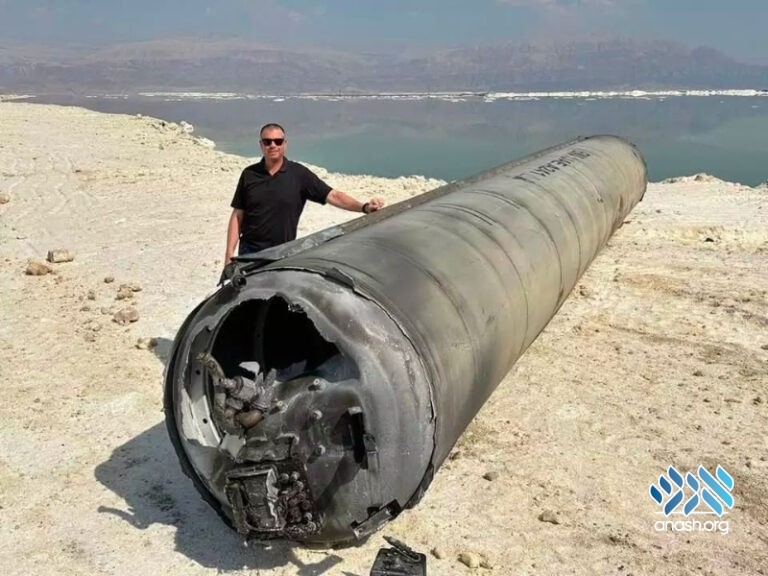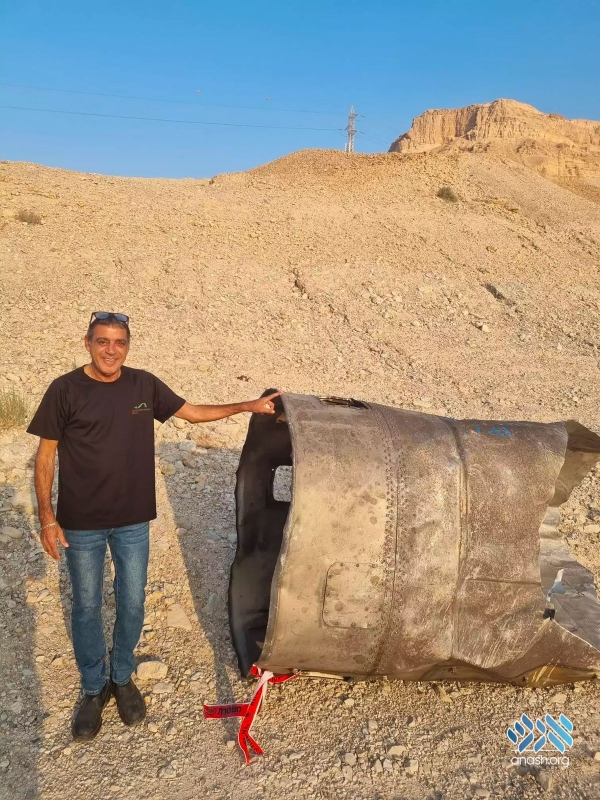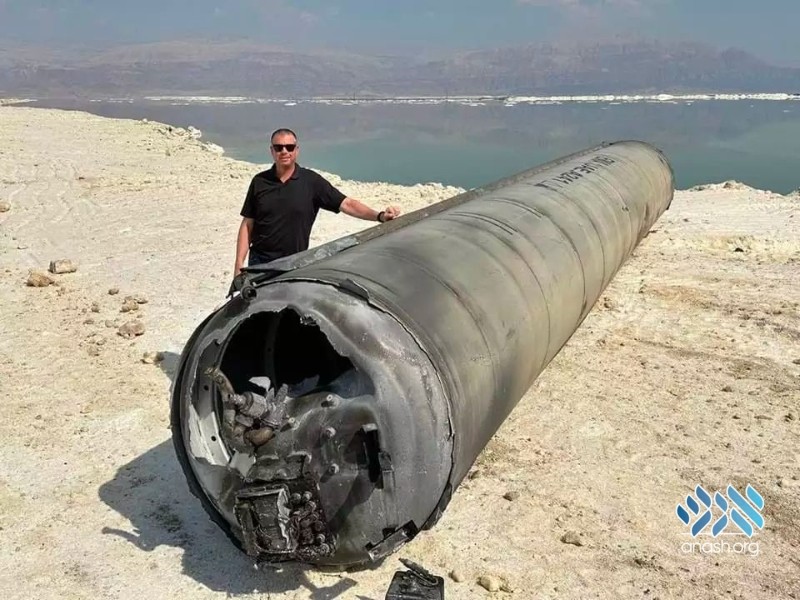War Summary, Day One Hundred and Ninety One: IDF Spokesman Rear Adm. Daniel Hagari said that Israel intercepted 99% of the projectiles fired at Israel from Iran last night, the IDF is preparing to call up two reserve brigades to the Gaza front for “operational missions,” and IDF combat engineers built a bridge for tanks to cross over the Wadi Gaza river.
By Mrs. Bruria Efune
War Summary, Day One Hundred and Ninety One:
133 held captive in Gaza.
112 hostages freed.
12 hostage bodies rescued.
37 hostages confirmed murdered in Gaza.
1,490 Israelis murdered.
260 fallen soldiers in the battle in Gaza.
6 fallen soldiers in Northern Israel.
4 fallen soldiers in Judea & Samaria.
11,600+ injured.
13,400 estimated rockets fired at Israel.
102,100 Israelis displaced from their homes.
1 Jewish nation united in prayer, charity, and good deeds.
Top Headlines:
- Hamas refuses all hostage negotiation offers
- Miraculous summary of the Iranian attack
- U.S. and G7 ask Israel not to retaliate Iranian attack
- Israel will likely respond to Iranian attack
- Iran issues severe threats in case of retaliation
- IDF calling up additional reserves to Gaza front
- Gaza civilians attempt to return north
- Israel attacks Hezbollah targets deep into Lebanon
- Houthi drone intercepted over the Red Sea
Hostage Updates:
Hamas is continuing to demand a complete IDF withdrawal before the release of the Israeli hostages.
The Tikva Forum, which represents some of the families of the hostages, stated: “Hamas is not deterred enough and not afraid enough to return our children, so it refuses the deal. We appeal to the Prime Minister and the War Cabinet to step on the gas, add international support, and change the equation.”
Iranian Front Updates:
Home Front Command restrictions were lifted in most of Israel, allowing children to return to daycare and Pesach (Passover) break camps on Monday.
In a review of last night’s attack from Iran, IDF Spokesman Rear Adm. Daniel Hagari said that Israel intercepted 99% of the projectiles fired at Israel last night, detailing:
- 170 UAVs (attack drones), all of which were downed before entering Israeli airspace by Israel and allies.
- 30 cruise missiles, all of which were downed before entering Israeli airspace, 25 of them by Israel.
- 120 ballistic missiles, most of which were downed by Israeli air defenses within Israel, and a few of which landed in Israel, hitting the Nevatim Airbase, where they caused minimal damage, and did not disrupt operational ability.
- A small number of drones and missiles were launched from Iranian proxies in Iraq and Yemen, all were intercepted before entering Israeli airspace.
- The projectiles had a combined total of 60 tons of explosives—what could have caused tremendous damage.
The Iranian attack is deemed to be over for now.
Amina Elhasuny, a 7 year-old Bedouin Israeli girl, is in the pediatric ICU fighting for her life after being injured by shrapnel from an intercepted ballistic missile. Eight others were treated for light injuries, some from shrapnel, but most from injuries while running to shelter, or from shock. Miraculously, there were no fatalities from the attack, despite the massive size of the missiles and fallen shrapnel.
Officials at the US Department of Defense told The Washington Post this evening that the US characterizes the Iranian attack as the most serious scenario it has observed. The officials denied the reports that Iran announced its plans three days in advance, and emphasized that Iran’s goal was to cause destruction and death.
While the Israeli Air Force downed most of the drones and cruise missiles, they were also assisted by the United States, United Kingdom, France, and Jordan. Jordan also allowed Israeli fighter jets to use their closed airspace for interceptions. Jordan’s assistance, though limited to protecting their own airspace, is very notable, being that Jordan was once a country at war with Israel, and the ones firing the rockets into Israel.
An unnamed official from the Saudi royal family told the Kan public broadcast that “any suspicious object” that enters Saudi Arabian airspace is intercepted—a possible confirmation of rumors that the Saudis also assisted in interceptions. (The source was also quoted criticizing Iran for engineering a war in Gaza in order to halt the normalization progress between Saudi Arabia and Israel.)
Today (Sunday), Defense Minister Yoav Gallant visited one of the Arrow 3 air defense systems, which was used to intercept the ballistic missiles—some in the exosphere. Gallant lauded the preparations done with the Americans and other partners, for the successful results brought in, and noted that this presented “an opportunity here to establish a strategic alliance against this serious threat from Iran, which threatens to put nuclear explosives on the heads of these missiles, this thing could be a very serious threat. The US, Israel and its allies stand shoulder to shoulder to defend against this threat.”
IDF Chief of Staff Lt. Gen. Herzi Halevi spoke with and thanked Gen. Michael Erik Kurilla, chief of the U.S. Central Command (CENTCOM).
Israel’s war cabinet met at IDF HQ today, and discussed a possible response to Iran. In choosing a response, Israel needs to heavily weigh various positions:
U.S. President Biden has asked that Israel not attack Iran in retaliation, and reportedly, asked that all members of the G7 also ask Israel the same. While all of the G7 put out strong statements of support for Israel and condemnation of Iran’s attack, and some even assisted in the defense, a larger war with Iran is not in their immediate interests. Iran has explicitly threatened the U.S. with direct retaliation on U.S. troops in Iraq if they back an Israeli response, and threatened Israel with a tenfold retaliation.
Within Israel, many (including all of the elected government) are of the opinion that Iran cannot be allowed to get away with such an attack without a strong response from Israel that will deter them from attacking again in the future—otherwise Israel may now face occasional fire directly from Iran, in the same way as Israel has been absorbing regular attacks from Iran’s proxies, Hamas and Hezbollah.
Axios reporter, Barak Ravid quoted three anonymous Israeli officials who said that ministers Benny Gantz and Gadi Eizenkot — both former IDF chiefs of staff — proposed to launch a counterattack immediately upon Iran’s launch of the first drones. This would be both an attempt to prevent the oncoming rounds, and to strike back while support was still strong. PM Netanyahu however wanted to wait and see the severity of the attack, and speak with President Biden.
Reports indicate that the war cabinet has chosen to respond in some way, some time soon, likely in a precision attack based on intelligence from Mossad contacts in Iran. It’s important to emphasize that Israel is not at war with the Iranian people—many or most of whom actually support Israel—but with the Iranian regime who oppress them as well. Israel will also try to minimize the likelihood of further escalation. We’re yet to see if the response will be in the usual style of attacks on Iran, in which Israel does not confirm involvement, or in a direct public attack.
Gaza Front Updates:
Hamas did not successfully launch any rockets at Israeli civilians today.
Thank G-d, the IDF did not announce the names of any fallen soldiers today.
The IDF is preparing to call up two reserve brigades to the Gaza front, for “operational missions.”
One brigade continues to operate in Central Gaza, primarily locating and eliminating terrorists in the outskirts of Nuseirat, and locating hidden rocket launchers. There are up to tens of thousands of launchers hidden throughout the Gaza Strip, often buried in sand or under camouflage which can’t be seen from above. IDF troops need to tediously locate and destroy each launcher. This is something that even from the beginning of the war was expected to take years to do.
Select IDF units are also carrying out pinpoint operations in various locations in Gaza, based on intelligence gathered from terrorists who surrendered, sources on ground, and tracking Hamas and the PIJ with surveillance cameras on ground and in the sky—something much easier to do now that most tunnels are destroyed and there are less places to hide.
IDF combat engineers built a bridge for tanks to cross over the Wadi Gaza river.
Hundreds of civilians in Gaza attempted to return to Northern Gaza today, after Hamas told them that the IDF would let them back in. The IDF troops turned them around, since the north is still an active war zone.
Gaza Humanitarian Efforts Updates:
Over the past 24 hours:
316 aid trucks inspected and transferred to Gaza.
65 food aid trucks coordinated to northern Gaza.
12 coordinations submitted, 11 approved and carried out, 1 denied for operational reasons.
This morning, a World Food Program bakery reopened in Northern Gaza. This bakery produces approximately 650,000 pita breads daily. The bakery joins two other bakeries that reopened in Central Gaza last week.
More than 23 bakeries are operational in Gaza, providing over 3 million pita breads daily.
Outdoor markets in Northern Gaza are full with a large variety of food out in the open, with no fear of theft—a clear sign that famine is not a concern.
Northern Front Updates:
In addition to assisting in Iran’s attack last night, Hezbollah fired missiles from Lebanon onto Israeli communities on the border today.
Typically, in an effort to avoid escalation with Hezbollah, the IDF only attacks Hezbollah targets in Southern Lebanon, and shells positions along the border. Only on occasion when Hezbollah escalates, the IDF attacks a limited number of Hezbollah targets further into Lebanon.
Since last night, the IDF attacked both with the usual, and in northeast Lebanon, in the Nabi Chit area. The IDF says it used an airstrike to hit a “significant weapons manufacturing site” belonging to Hezbollah.
Israel’s defense establishment has repeatedly reassured Israelis that Hezbollah will be taken care of, either diplomatically, or otherwise. France is leading diplomatic talks, which seem to be going nowhere. Hezbollah has been keeping their attacks to a limited zone in the far north, while still incurring significant damage, and 16 fatalities to Israel. There is strong speculation that the IDF is waiting until it is finished in Rafah, Gaza, before focusing on the north, in order to avoid a two-front war.
Houthi War Front Updates:
On Sunday evening, the IDF intercepted a “suspicious aerial target,” likely an attack drone from the Iranian-backed Houthis in Yemen. It was intercepted by the C-Dome, which is an Iron Dome-like system mounted on one of the Navy’s Sa’ar 6-class corvettes. The is the second ever such interception.
IDF combat engineers built bridges for tanks to cross the Wadi Gaza river.
The IDF releases footage showing some of the minor damage at the Nevatim Airbase in southern Israel, after it was hit by Iranian ballistic missiles overnight. The damage was minor ad did not affect operations in any way.
The IDF released footage showing Israeli Air Force fighter jets downing some of the 170 drones and 30 cruise missiles fired from Iran at Israel overnight.



Discussion
In keeping in line with the Rabbonim's policies for websites, we do not allow comments. However, our Rabbonim have approved of including input on articles of substance (Torah, history, memories etc.)
We appreciate your feedback. If you have any additional information to contribute to this article, it will be added below.